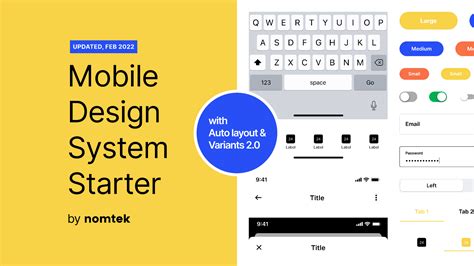Mobile Design System Essentials

As the world becomes increasingly mobile, the importance of effective mobile design systems cannot be overstated. A well-crafted mobile design system is essential for providing users with seamless, intuitive, and engaging experiences across various devices and platforms. In this article, we will delve into the core principles and best practices of mobile design systems, exploring the key elements that contribute to their success. With a deep understanding of these essentials, designers and developers can create mobile applications and websites that not only meet but exceed user expectations.
Understanding Mobile Design Systems

A mobile design system is a comprehensive framework that encompasses the principles, patterns, and guidelines for designing mobile interfaces. It serves as a unified language, ensuring consistency across all aspects of the mobile experience, from the layout and typography to the color palette and interactions. By establishing a clear design system, teams can ensure that their mobile applications and websites are cohesive, user-friendly, and aligned with the brand’s identity.
At the heart of any successful mobile design system are several key components, including a design language, pattern library, and style guide. The design language provides the foundational principles and elements that define the visual and interactive aspects of the design. The pattern library is a collection of reusable UI components and templates that adhere to the design language, facilitating the creation of consistent interfaces. Lastly, the style guide outlines the rules and guidelines for implementing the design system, ensuring that all designers and developers are on the same page.
Mobile-First Approach
Adopting a mobile-first approach is crucial when developing a mobile design system. This strategy involves designing for the smallest screen first and then progressively enhancing the design for larger screens. By doing so, designers are forced to prioritize content, simplify interactions, and optimize performance, resulting in a more focused and efficient user experience. A mobile-first approach also encourages the use of responsive design techniques, allowing the interface to adapt seamlessly to different screen sizes and orientations.
| Design Principle | Description |
|---|---|
| Simple and Consistent | Interfaces should be easy to navigate and consistent in their design elements |
| Intuitive Interactions | Interactions should be natural and intuitive, leveraging common mobile patterns and gestures |
| Performance Optimization | Designs should be optimized for fast load times and smooth performance, even on lower-end devices |

Key Points
- A well-crafted mobile design system is essential for providing users with seamless and intuitive experiences
- A mobile-first approach is crucial for prioritizing content, simplifying interactions, and optimizing performance
- A successful mobile design system consists of a design language, pattern library, and style guide
- Designers should prioritize simplicity, consistency, and intuitive interactions when crafting mobile interfaces
- Performance optimization is critical for ensuring fast load times and smooth performance on mobile devices
Designing for Mobile Devices

When designing for mobile devices, it’s essential to consider the unique characteristics and limitations of these devices. This includes screen size and resolution, touch and gesture-based interactions, and device capabilities like location services and cameras. By understanding these factors, designers can create interfaces that are tailored to the mobile context, providing users with a more engaging and effective experience.
Another critical aspect of mobile design is accessibility. Designers should strive to create interfaces that are usable by everyone, regardless of their abilities or disabilities. This involves incorporating features like high contrast modes, large text options, and assistive technologies like screen readers. By prioritizing accessibility, designers can ensure that their mobile applications and websites are inclusive and usable by the widest possible audience.
Mobile Design Patterns and Trends
Staying up-to-date with the latest mobile design patterns and trends is essential for creating modern and effective mobile interfaces. This includes incorporating minimalist and simple designs, bold typography and color schemes, and interactive and dynamic elements like animations and micro-interactions. By leveraging these patterns and trends, designers can create mobile applications and websites that are visually appealing, engaging, and aligned with user expectations.
What is the importance of a mobile design system?
+A mobile design system is essential for providing users with seamless, intuitive, and engaging experiences across various devices and platforms. It ensures consistency, simplifies the design process, and improves the overall quality of the mobile application or website.
How do I get started with designing a mobile design system?
+To get started with designing a mobile design system, begin by defining your design principles, creating a design language, and establishing a pattern library. It's also essential to develop a style guide that outlines the rules and guidelines for implementing the design system.
What are some common mobile design patterns and trends?
+Some common mobile design patterns and trends include minimalist and simple designs, bold typography and color schemes, and interactive and dynamic elements like animations and micro-interactions. It's essential to stay up-to-date with the latest trends and patterns to create modern and effective mobile interfaces.
In conclusion, a well-crafted mobile design system is critical for providing users with seamless, intuitive, and engaging experiences across various devices and platforms. By understanding the key components of a mobile design system, adopting a mobile-first approach, and staying up-to-date with the latest design patterns and trends, designers and developers can create mobile applications and websites that meet and exceed user expectations. Remember to prioritize simplicity, consistency, and accessibility, and don't be afraid to experiment and innovate in the ever-evolving world of mobile design.
Meta Description: Learn the essentials of mobile design systems, including key components, mobile-first approach, and design patterns. Create seamless and intuitive mobile experiences with our expert guide. (150 characters)



